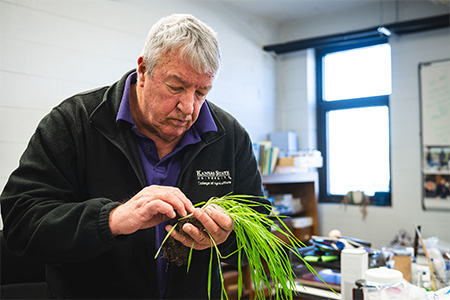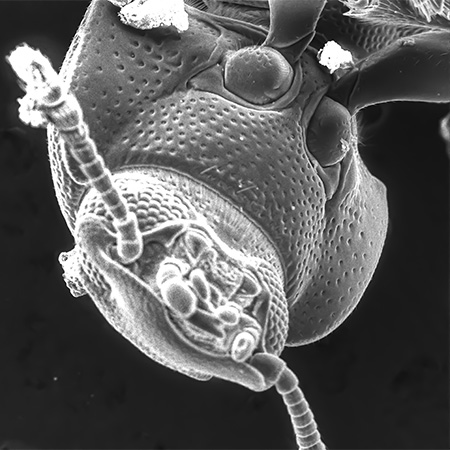Farming's future includes nanotechnology
Small and mighty
By Pat Melgares
In late 2022, Kansas State University entomologists took a bold step in their quest to take on the pests that stunt the growth of agricultural crops: They entered the nanoworld.
More specifically, they joined with U.S. Department of Agriculture scientists to launch a four-year project employing nanotechnology, a branch of science and engineering devoted to designing, producing and using particles of matter that are measured in nanometers or microns.
According to the U.S. government’s National Nanotechnology Initiative, materials produced using nanotechnology are stronger, lighter, more durable, more reactive and better electrical conductors, among many other benefits. The National Institute for Occupational Safety and Health describes the technology as promising for such sectors as medicine, consumer products, energy, materials and manufacturing.
Nanomaterials are used in many well-known electronic devices, such as smartphones, laptops and televisions, improving the conductivity, strength and durability of those items.
In agriculture, scientists believe they can develop nanoparticles that use one-tenth or fewer pesticides while reducing crop losses due to pests — factors that will reduce pesticide use in the environment and ultimately help farmers make more money.
And K-State is leading that charge.
Targeting ag pests
Just over a year and a half ago, the USDA awarded K-State a four-year grant to create a new area of research focused on nanotechnology in crop pest management.
“Seed treatments, which protect seeds and seedlings from early-season pests and disease, came along 40 years ago, and then came genetically modified crops to help with that as well,” said Jeff Whitworth, a field crop entomologist with K-State Research and Extension who leads the project.
“Well, in the next 20 years, we may lose those as effective ways to protect against pests and diseases, so we’ve got to come up with something new,” Whitworth said.
 In part, the USDA funds were used to hire Amie Norton, a former USDA employee who specializes in nanotechnology. Norton, whose background is in chemistry, said her job involves building nanoparticles in K-State laboratories that carry lower levels of active pesticide ingredients, and then applying those structures to crop fields.
In part, the USDA funds were used to hire Amie Norton, a former USDA employee who specializes in nanotechnology. Norton, whose background is in chemistry, said her job involves building nanoparticles in K-State laboratories that carry lower levels of active pesticide ingredients, and then applying those structures to crop fields.
“The advantage of nanotechnology is that you have a larger surface area to work with, and so more of the pesticide is applied even though we are using less material,” Norton said. “The increased loading of pesticides onto the surface of nanomaterials and their ability to increase the bioavailability of ingredients to targeted pests results in the use of less active ingredients such as pesticides, which leads to lower costs for those using these products.”
Whitworth said K-State’s project is expected to explore treatments for such pests as the Hessian fly, corn rootworm, grasshoppers, termites and even mosquitos.
“We’re looking at a wide range of medical, veterinary, household and agricultural pests,” he said. “In most of these areas, we hope to do at least a cursory look to determine if there is potential for nanotechnology.
“By the end of our four years, we’ll have an idea about whether there’s a place for anotechnology in agriculture,” Whitworth said.
A disciplined approach
By definition, a nanometer is one-billionth of a meter, so small that it cannot be detected by optical microscopes. For perspective:
- A strand of human hair is between 50,000 and 100,000 nanometers thick.
- One sheet of standard copy paper is 100,000 nanometers thick.
- The period at the end of this sentence is approximately 1 million nanometers.
- One nanometer compares to a standard tennis ball wide in the same proportion that the same tennis ball compares to planet Earth.
The applications being developed at K-State require special knowledge and highly sophisticated equipment. That’s where Norton comes in.
sophisticated equipment. That’s where Norton comes in.
It took nearly a year just to acquire all the specialty equipment that now creates a steady buzz in Norton’s modest basement-level laboratory.
For certain, she is methodical in her approach. In a recent test, Norton combined stainless steel balls with eggshells — an agricultural waste product — to create a green pesticide, so called because it is derived from organic sources that are considered environmentally friendly.
Whitworth notes that many agricultural waste products could be useful in developing nanomaterials. Last fall, the team tested the effectiveness of post-Halloween pumpkins. They’re also looking at postharvest residues of corn, wheat, sorghum and more.
“We’re starting to select and screen various green pesticides to see if there’s any value of using products that we don’t normally consider pesticides,” Whitworth said. “At the nano level, they may be more easily absorbed or taken up by the target pest.”
Norton’s test with eggshells made its way through a nanomill, where it was vigorously shaken for 30 minutes. Then it was on to an electric sprayer, where researchers can transform the liquid substance into fibers or small capsules.
There is equipment to measure the concentration of material available, view it in ultraviolet, test it against a target and coat the material with minerals as gold, silver or copper.
“Every nanoparticle is made differently,” Norton said, “depending on what you may want to accomplish.”
She said that nanotechnology may one day allow farmers to use a product that performs multiple functions. “For example, if you need fertilizer and pesticide together, you can purchase a product that would be much cheaper than buying the two separately,” Norton said.
In the future, Norton would like to investigate the possibility of layering, which would allow for the time-release of a pesticide.
“Currently, you put a product out there and it’s consumed — it’s gone,” she said. “But if we could create a second layer, we could extend the lifetime of that pesticide.”
Norton is also encouraged by the potential of creating safer products for unintended targets. One example could be through gating, which controls how the nanoparticle activates.
“Let’s say the insect you’re targeting has a stomach pH of three. Well, if a beneficial insect has a stomach pH of six, you can design the nanoparticle so that it only opens in an acidic environment,” Norton said. “We could gate materials so that if a child were to accidentally ingest the product, it would be gated so that it wouldn’t open into a human’s digestive tract.”
Early success
It took just about one year for K-State’s team of entomologists, USDA scientists and Norton to develop and use their first nano product. In October 2023, the researchers reported findings of a study in which they coupled silver — a known antimicrobial — with a corn protein known as zein, which is typically a waste product.
Their target: mosquitos, the pesky, picnic-ruining, biting pest of summer.
 K-State’s team tested its nanopesticide in water, believing that as mosquito larvae filter food from water, they ingest the nanomaterial containing silver.
K-State’s team tested its nanopesticide in water, believing that as mosquito larvae filter food from water, they ingest the nanomaterial containing silver.
“We found that in mosquito larvae, silver gets into their mid-gut and kills the microbes that are necessary for mosquito larval well-being,” Norton said.
The concentration of pesticide in the newly developed nanomaterial is, by far, less than what would traditionally be used to combat mosquito populations. According to Norton, K-State’s product included just 1 part per million pesticide — a proportion similar to one drop of water in a 10-gallon fish tank.
By comparison, more common pesticide concentrations range from 10 to 32 parts per million. In other words, K-State’s product used at least one-tenth — and possibly as much as one-thirtieth — less pesticide than what is commonly used.
Whitworth said that while silver is not a typical pesticide used in mosquito control, future applications are expected to include spinosad, which is more commonly used. Scientists may also include methoprene, a growth regulator, so that what doesn’t kill the mosquitoes will keep them from growing into adults.
While not an application for agriculture specifically, the mosquito project was proof positive of the K-State team’s ability to develop an application aimed at eliminating a real-world problem.
“We’re just a year into this area of research,” Whitworth said. “We are looking for ways to recycle agriculture waste and convert it into something useful. It’s a step-by-step process; it takes a while, and we are learning as we go.”
Watch a video and read more about K-State nanotechnology research for crop protection: